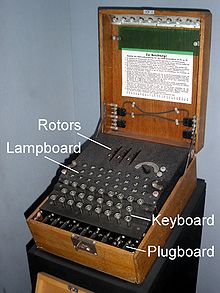
Back Kryptanalyse der Enigma German Cryptanalyse d'Enigma French פיצוח האניגמה HE Kriptanalisis Enigma ID 에니그마의 해독 Korean Łamanie szyfru Enigmy Polish Criptoanálise da Máquina Enigma Portuguese Криптоанализ «Энигмы» Russian Enigma şifrelemesinin analizi Turkish Криптоаналіз «Енігми» Ukrainian
| The Enigma cipher machine |
|---|
| Enigma machine |
| Breaking Enigma |
| Related |

Cryptanalysis of the Enigma ciphering system enabled the western Allies in World War II to read substantial amounts of Morse-coded radio communications of the Axis powers that had been enciphered using Enigma machines. This yielded military intelligence which, along with that from other decrypted Axis radio and teleprinter transmissions, was given the codename Ultra.
The Enigma machines were a family of portable cipher machines with rotor scramblers.[1] Good operating procedures, properly enforced, would have made the plugboard Enigma machine unbreakable to the Allies at that time.[2][3][4]
The German plugboard-equipped Enigma became the principal crypto-system of the German Reich and later of other Axis powers. In December 1932 it was "broken" by mathematician Marian Rejewski at the Polish General Staff's Cipher Bureau,[5] using mathematical permutation group theory combined with French-supplied intelligence material obtained from a German spy. By 1938 Rejewski had invented a device, the cryptologic bomb, and Henryk Zygalski had devised his sheets, to make the cipher-breaking more efficient. Five weeks before the outbreak of World War II, in late July 1939 at a conference just south of Warsaw, the Polish Cipher Bureau shared its Enigma-breaking techniques and technology with the French and British.
During the German invasion of Poland, core Polish Cipher Bureau personnel were evacuated via Romania to France, where they established the PC Bruno signals intelligence station with French facilities support. Successful cooperation among the Poles, French, and British continued until June 1940, when France surrendered to the Germans.
From this beginning, the British Government Code and Cypher School at Bletchley Park built up an extensive cryptanalytic capability. Initially the decryption was mainly of Luftwaffe (German air force) and a few Heer (German army) messages, as the Kriegsmarine (German navy) employed much more secure procedures for using Enigma. Alan Turing, a Cambridge University mathematician and logician, provided much of the original thinking that led to upgrading of the Polish cryptologic bomb used in decrypting German Enigma ciphers. However, the Kriegsmarine introduced an Enigma version with a fourth rotor for its U-boats, resulting in a prolonged period when these messages could not be decrypted. With the capture of cipher keys and the use of much faster US Navy bombes, regular, rapid reading of U-boat messages resumed.
- ^ Reuvers, Paul; Simons, Marc (2010), Enigma Cipher Machine, retrieved 22 July 2010
- ^ Welchman 1997, p. 3
- ^ Calvocoressi 2001, p. 66
- ^ Huttenhain & Fricke 1945, pp. 4, 5.
- ^ "Poland's Decisive Role in Cracking Enigma and Transforming the UK's SIGINT Operations".
© MMXXIII Rich X Search. We shall prevail. All rights reserved. Rich X Search